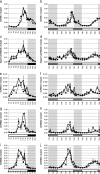Expression conservation within the circadian clock of a monocot: natural variation at barley Ppd-H1 affects circadian expression of flowering time genes, but not clock orthologs
- PMID: 22720803
- PMCID: PMC3478166
- DOI: 10.1186/1471-2229-12-97
Expression conservation within the circadian clock of a monocot: natural variation at barley Ppd-H1 affects circadian expression of flowering time genes, but not clock orthologs
Abstract
Background: The circadian clock is an endogenous mechanism that coordinates biological processes with daily changes in the environment. In plants, circadian rhythms contribute to both agricultural productivity and evolutionary fitness. In barley, the photoperiod response regulator and flowering-time gene Ppd-H1 is orthologous to the Arabidopsis core-clock gene PRR7. However, relatively little is known about the role of Ppd-H1 and other components of the circadian clock in temperate crop species. In this study, we identified barley clock orthologs and tested the effects of natural genetic variation at Ppd-H1 on diurnal and circadian expression of clock and output genes from the photoperiod-response pathway.
Results: Barley clock orthologs HvCCA1, HvGI, HvPRR1, HvPRR37 (Ppd-H1), HvPRR73, HvPRR59 and HvPRR95 showed a high level of sequence similarity and conservation of diurnal and circadian expression patterns, when compared to Arabidopsis. The natural mutation at Ppd-H1 did not affect diurnal or circadian cycling of barley clock genes. However, the Ppd-H1 mutant was found to be arrhythmic under free-running conditions for the photoperiod-response genes HvCO1, HvCO2, and the MADS-box transcription factor and vernalization responsive gene Vrn-H1.
Conclusion: We suggest that the described eudicot clock is largely conserved in the monocot barley. However, genetic differentiation within gene families and differences in the function of Ppd-H1 suggest evolutionary modification in the angiosperm clock. Our data indicates that natural variation at Ppd-H1 does not affect the expression level of clock genes, but controls photoperiodic output genes. Circadian control of Vrn-H1 in barley suggests that this vernalization responsive gene is also controlled by the photoperiod-response pathway. Structural and functional characterization of the barley circadian clock will set the basis for future studies of the adaptive significance of the circadian clock in Triticeae species.
Figures





References
-
- McClung RC. Linking the loops. Science. 2009;13:1440–1441. - PubMed
Publication types
MeSH terms
Substances
LinkOut - more resources
Full Text Sources
Molecular Biology Databases

